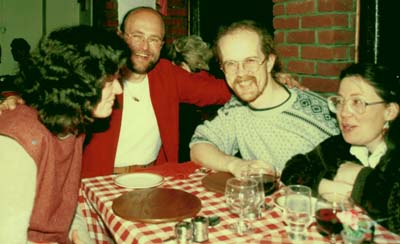
Dzogchen informal symbolic transmission
Ngala Nor’dzin & Ngala ’ö-Dzin celebrating a reunion with the Gyüdpa’i Lamas of the Aro gTér
This picture was taken in 1989 on the occasion of Ngak’chang Rinpoche and Khandro Déchen’s personal visit. Ngak’chang Rinpoche and Khandro Déchen have always discussed the future of the Confederate Sanghas of Aro with their ordained disciples and Ngakma Nor’dzin and Ngakpa ’ö-Dzin have therefore partaken of many social occasions with their lineage Lamas. Social interaction has always been an important aspect of Ngak’chang Rinpoche and Khandro Déchen’s relationship with their apprentices (gé’trug – ge ’phrug) and disciples (dorje ngö-lob – rDo rJe dNos sLob), and now Ngakma Nor’dzin and Ngakpa ’ö-Dzin continue this intimate tradition with their own apprentices.
Social interaction, in relation to Dzogchen, can be a powerful vehicle for transmission – particularly in the sense of ‘Dzogchen informal symbolic transmission’. Within the Dzogchen teachings there are three means of transmission. These are known as Direct, Symbolic, and Oral. Direct is Mind-to-Mind transmission; Symbolic requires a few cryptic words together with the display of a device such as a mélong; Oral is contained within any explanation of Dzogchen and Dzogchen practices. Symbolic can be divided into ‘formal symbolic transmission’ and ‘informal symbolic transmission’ – the first is as previously described, and the second is unlimited. ‘Dzogchen Informal symbolic transmission’ could manifest through the Lama adopting an unusual tone of voice or facial expression, or it could be an unusual movement or behavioural display. There are many stories of ‘Dzogchen informal symbolic transmission’ from Tibet which are inspiring to read in conjunction with having experienced similar manifestations in the company of one’s own Lamas.
Ngak’chang Rinpoche and Khandro Déchen are particularly fond of the dinner setting as a means of encouraging more oblique entrances to Dzogchen transmission. Ngala Nor’dzin and Ngala ’ö-Dzin often dine with Ngak’chang Rinpoche and Khandro Déchen in order to discuss the evolution of their sangha and questions arising from the dissemination of the teachings.
Ngakma Nor’dzin
says of this:
There have been many occasions when we have been laughing and joking together
with Ngak’chang Rinpoche and Khandro Déchen – when suddenly the emphasis shifted
and we were aware that we were receiving a teaching and the transmission of living the view. The
sense of transmission is beyond concept and intellect. On many occasions I have become aware of
the atmosphere of a conversation changing. I would sense a stillness of mind, and a sensation at
the centre of my body as if a wave of direct communication had passed through me. The recognition
of such moments of transmission smoulders within me and, over the years, these experiences have
grown into the warmth of continuing devotion, and openness to the potential for transmission of
every moment with my Lamas. I have only to think of Ngak’chang Rinpoche and Khandro
Déchen or visualise their presence for the warmth of devotion and sense of transmission to
flare within me – often causing tears to prick my eyes.
Ngakpa ’ö-Dzin
says of this occasion:
I remember one of the first occasions when Ngak’chang Rinpoche
turned a joke on its head. It was at the Ziopin restaurant in Roath, Cardiff and Ngak’chang
Rinpoche moved from a quip about Sambucha and sambhogakaya to discussing the nature of spirit as
both liquid and gas in terms of how it can be ignited. The glass became the mandala. The Sambucha
became nirmanakaya in relation to its volatile gas as sambhogakaya, and its flame as the wisdom
fire of dharmakaya. It was a simple statement – but in the context of the moment it became
transmission, and I understood that being open is more important than having an enormous
intellect.
